在无急性病、事故或损伤的情况下,难以确认破坏正常音质和正常发音的病因。此外,一些喉部和喉外疾病与声音嘶哑的发展相关。这些疾病可分为功能性、炎性、良性、神经性、恶性或恶性倾向。目前尚无足够证据表明甲状腺功能减退症会造成嘶哑。
功能性障碍
肌紧张性发音障碍[2]Roy N. Functional dysphonia. Curr Opin Otolaryngol Head Neck Surg. 2003;11:144-148.http://www.ncbi.nlm.nih.gov/pubmed/12923352?tool=bestpractice.com
该疾病也称为肌肉误用性发声障碍,病因是喉部内外肌肉的失衡状态阻碍声音的产生。
与多种交互因素有关,包括胃食管反流病 (GORD)、喉咽反流 (LPR)、哮喘、变态反应、鼻窦炎、神经肌肉异常、声音的使用及行为、情绪、抑郁或焦虑。[3]Morrison M. Pattern recognition in muscle misuse voice disorders: how I do it. J Voice. 1997;11:108-114.http://www.ncbi.nlm.nih.gov/pubmed/9075184?tool=bestpractice.com[4]Altman KW, Atkinson C, Lazarus C. Current and emerging concepts in muscle tension dysphonia: a 30-month review. J Voice. 2005;19:261-267.http://www.ncbi.nlm.nih.gov/pubmed/15907440?tool=bestpractice.com内向型人格也可能是肌紧张性发音障碍的病因。[5]Roy N, Bless DM, Heisey D. Personality and voice disorders: a multitrait-multidisorder analysis. J Voice 2000;14:521-548.http://www.ncbi.nlm.nih.gov/pubmed/11130110?tool=bestpractice.com[6]Roy N, Bless DM, Heisey D. Personality and voice disorders: a superfactor trait analysis. J Speech Lang Hear Res 2000;43:749-768.http://www.ncbi.nlm.nih.gov/pubmed/10877443?tool=bestpractice.com
在原发性肌紧张性发音障碍中,喉肌失衡发生于上呼吸道感染 (URTI)、压力或情感创伤后。诱发事件可能会消退,遗留下嗓音变化。[7]Verdolini K, Rosen C, Branski R, eds. Classification manual for voice disorders: I. Mahwah, NJ: Lawrence Erlbaum Associates, Inc; 2005.[8]Altman KW. Vocal fold masses. Otolaryngol Clin North Am. 2007;40:1091-1108.http://www.ncbi.nlm.nih.gov/pubmed/17765697?tool=bestpractice.com
在继发性肌紧张性发音障碍中,继发于相关器质性或精神性疾病(转换障碍)的代偿行为会导致喉肌失衡。[2]Roy N. Functional dysphonia. Curr Opin Otolaryngol Head Neck Surg. 2003;11:144-148.http://www.ncbi.nlm.nih.gov/pubmed/12923352?tool=bestpractice.com
声带协调运动
以吸气时声带内收而非外展/张开为特征的呼吸紊乱。[9]Andrianopoulos MV, Gallivan GJ, Gallivan KH. PVCM, PVCD, EPL, and irritable larynx syndrome: what are we talking about and how do we treat it? J Voice. 2000;14:607-618.http://www.ncbi.nlm.nih.gov/pubmed/11130117?tool=bestpractice.com[10]Maschka DA, Bauman NM, McCray PB Jr, et al. A classification scheme for paradoxical vocal cord motion. Laryngoscope. 1997;107:1429-1435.http://www.ncbi.nlm.nih.gov/pubmed/9369385?tool=bestpractice.com[11]Mathers-Schmidt BA. Paradoxical vocal fold motion: a tutorial on a complex disorder and the speech-language pathologist's role. Am J Speech Lang Pathol. 2001;10:111-125.
继发于喉易激惹综合征或高动力性喉功能障碍。[12]Altman KW, Simpson CB, Amin MR, et al. Cough and paradoxical vocal fold motion. Otolaryngol Head Neck Surg. 2002;127:501-511.http://www.ncbi.nlm.nih.gov/pubmed/12501100?tool=bestpractice.com
呼吸困难可能由以下原因诱发,如运动、坐下、进食、睡觉、空气传播的刺激物(烟、香水、化学气味)、[11]Mathers-Schmidt BA. Paradoxical vocal fold motion: a tutorial on a complex disorder and the speech-language pathologist's role. Am J Speech Lang Pathol. 2001;10:111-125.极端温度和压力等,随诱发因素的去除而消退。[13]Morrison M, Rammage L, Emami AJ. The irritable larynx syndrome. J Voice. 1999;13:447-455.http://www.ncbi.nlm.nih.gov/pubmed/10498060?tool=bestpractice.com
炎症原因
长期严重炎症会损害喉部组织。不过,炎性过程有时有益于限制损伤区域及促进愈合修复。应迅速积极地治疗重度感染及导致喉部炎症的其他疾病。多种原因可导致喉部炎症。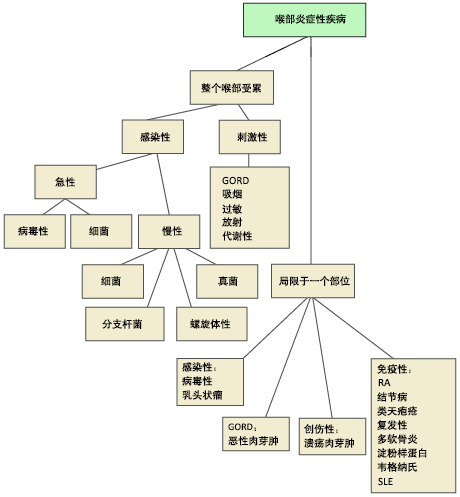 [Figure caption and citation for the preceding image starts]: Mirza 炎症树经许可转载自 Merati AL 和 Bielamowicz SA(编)。喉科学教材。加利福尼亚圣地亚哥:Plural Publishing 公司于 2006 年出版。保留所有权利。 [Citation ends].
[Figure caption and citation for the preceding image starts]: Mirza 炎症树经许可转载自 Merati AL 和 Bielamowicz SA(编)。喉科学教材。加利福尼亚圣地亚哥:Plural Publishing 公司于 2006 年出版。保留所有权利。 [Citation ends].
急性喉部炎症
作为感染、外伤或手术的应激反应迅速发作。
病因包括呼吸道感染(细菌性、病毒性、真菌性)、结核病 (TB)、发声创伤和/或环境刺激或有毒物质的暴露。
体征包括红斑、水肿、溃疡及功能丧失。
急性喉炎的大多数病因具有自限性。[14]Dworkin JP. Laryngitis: types, causes, and treatments. Otolaryngol Clin North Am. 2008;41:419-436.http://www.ncbi.nlm.nih.gov/pubmed/18328379?tool=bestpractice.com
慢性喉部炎症
反流性喉炎 [Figure caption and citation for the preceding image starts]: 反流性喉炎由 Wisconsin 大学医药和公共健康学院提供 [Citation ends].
[Figure caption and citation for the preceding image starts]: 反流性喉炎由 Wisconsin 大学医药和公共健康学院提供 [Citation ends].
继发于 LPR。
可能并发声带肉芽肿形成、误吸、喉痉挛以及声门下狭窄。[7]Verdolini K, Rosen C, Branski R, eds. Classification manual for voice disorders: I. Mahwah, NJ: Lawrence Erlbaum Associates, Inc; 2005.
亚急性喉部炎症尚无明确定义,很少确诊,由片段事件如环境刺激物或过敏原暴露引起。
声带良性病变
声带良性病变的特征是声带固有层浅层的细胞外基质蛋白结构紊乱。[7]Verdolini K, Rosen C, Branski R, eds. Classification manual for voice disorders: I. Mahwah, NJ: Lawrence Erlbaum Associates, Inc; 2005.研究这些病变的组织学有助于消除关于其分类的混乱,使病理医生更准确地鉴别特定病变。[15]Thibeault SL. Advances in our understanding of the Reinke space. Curr Opin Otolaryngol Head Neck Surg. 2005;13:148-151.http://www.ncbi.nlm.nih.gov/pubmed/15908811?tool=bestpractice.com[16]Thibeault SL, Gray SD, Bless DM, et al. Histologic and rheologic characterization of vocal fold scarring. J Voice. 2002;16:96-104.http://www.ncbi.nlm.nih.gov/pubmed/12002893?tool=bestpractice.com[17]Thibeault SL, Hirschi SD, Gray SD. DNA microarray gene expression analysis of a vocal fold polyp and granuloma. J Speech Lang Hear Res. 2003;46:491-502.http://www.ncbi.nlm.nih.gov/pubmed/14700388?tool=bestpractice.com[18]Johns MM. Update on the etiology, diagnosis, and treatment of vocal fold nodules, polyps, and cysts. Curr Opin Otolaryngol Head Neck Surg. 2003;11:456-461.http://www.ncbi.nlm.nih.gov/pubmed/14631179?tool=bestpractice.com
声带小结、囊肿、息肉、 [Figure caption and citation for the preceding image starts]: 声带息肉由 Wisconsin 大学医药和公共健康学院提供 [Citation ends].纤维性肿块、肉芽肿和瘢痕
[Figure caption and citation for the preceding image starts]: 声带息肉由 Wisconsin 大学医药和公共健康学院提供 [Citation ends].纤维性肿块、肉芽肿和瘢痕
发病原因是:声带过度使用/使用不当或发声创伤造成过大机械应力,进而对声带组织造成损伤和炎症并引发异常生理愈合。[7]Verdolini K, Rosen C, Branski R, eds. Classification manual for voice disorders: I. Mahwah, NJ: Lawrence Erlbaum Associates, Inc; 2005.[18]Johns MM. Update on the etiology, diagnosis, and treatment of vocal fold nodules, polyps, and cysts. Curr Opin Otolaryngol Head Neck Surg. 2003;11:456-461.http://www.ncbi.nlm.nih.gov/pubmed/14631179?tool=bestpractice.com如果在早期消除了诱发因素,则水肿和声带小结可能可逆。
发声创伤由各种发音行为引起,如喉肌张力增大;硬起声;音调异常及音调缺少变化;说话过多;长期音量过大;肿胀期间过度或紧张用声;炎症或其他组织病理改变;过多咳嗽和清嗓;尖叫或发出其他噪音;在体育赛事中欢呼、教学、带领啦啦队及未经训练唱歌时用声不当。[19]Colton RH, Casper JK, Leonard R. Understanding voice problems: a physiological perspective for diagnosis and treatment. Baltimore, MD: Lippincott Williams & Wilkins; 2006.[7]Verdolini K, Rosen C, Branski R, eds. Classification manual for voice disorders: I. Mahwah, NJ: Lawrence Erlbaum Associates, Inc; 2005.
脱水、慢性或复发性呼吸道感染(细菌性、病毒性、真菌性)、TB、LPR、发声创伤及环境中刺激或有毒物质的暴露也是以上病变的致病因素。[7]Verdolini K, Rosen C, Branski R, eds. Classification manual for voice disorders: I. Mahwah, NJ: Lawrence Erlbaum Associates, Inc; 2005.
患声带良性病变的人通常是社交活动中占主导地位的性格外向者。[5]Roy N, Bless DM, Heisey D. Personality and voice disorders: a multitrait-multidisorder analysis. J Voice 2000;14:521-548.http://www.ncbi.nlm.nih.gov/pubmed/11130110?tool=bestpractice.com[6]Roy N, Bless DM, Heisey D. Personality and voice disorders: a superfactor trait analysis. J Speech Lang Hear Res 2000;43:749-768.http://www.ncbi.nlm.nih.gov/pubmed/10877443?tool=bestpractice.com尽管心理压力与声带良性病变发生有关,但这种关联有待进一步研究。[20]Dietrich M, Verdolini Abbott K, Gartner-Schmidt J, et al. The frequency of perceived stress, anxiety, and depression in patients with common pathologies affecting voice. J Voice. 2008;22:472-488.http://www.ncbi.nlm.nih.gov/pubmed/18395419?tool=bestpractice.com[8]Altman KW. Vocal fold masses. Otolaryngol Clin North Am. 2007;40:1091-1108.http://www.ncbi.nlm.nih.gov/pubmed/17765697?tool=bestpractice.com[2]Roy N. Functional dysphonia. Curr Opin Otolaryngol Head Neck Surg. 2003;11:144-148.http://www.ncbi.nlm.nih.gov/pubmed/12923352?tool=bestpractice.com
声带囊肿可能为先天性或获得性。 [Figure caption and citation for the preceding image starts]: 声带囊肿由 Wisconsin 大学医药和公共健康学院提供 [Citation ends].黏液潴留囊肿是由于黏液腺阻塞,表皮样囊肿则是由发声创伤或声带上皮残留在固有层中层引起。[7]Verdolini K, Rosen C, Branski R, eds. Classification manual for voice disorders: I. Mahwah, NJ: Lawrence Erlbaum Associates, Inc; 2005.
[Figure caption and citation for the preceding image starts]: 声带囊肿由 Wisconsin 大学医药和公共健康学院提供 [Citation ends].黏液潴留囊肿是由于黏液腺阻塞,表皮样囊肿则是由发声创伤或声带上皮残留在固有层中层引起。[7]Verdolini K, Rosen C, Branski R, eds. Classification manual for voice disorders: I. Mahwah, NJ: Lawrence Erlbaum Associates, Inc; 2005.
形成声带肉芽肿的原因是后声门和声带受到长期或反复创伤(发声创伤或插管后创伤)以及酸刺激(继发于 LPR)。[14]Dworkin JP. Laryngitis: types, causes, and treatments. Otolaryngol Clin North Am. 2008;41:419-436.http://www.ncbi.nlm.nih.gov/pubmed/18328379?tool=bestpractice.com[21]Mirza N. Localized inflammatory disorders of the larynx. In: Merati AL, Bielamowicz SA, eds. Textbook of laryngology. San Diego, CA: Plural Publishing; 2006: 272. [Figure caption and citation for the preceding image starts]: 肉芽肿 1由 Wisconsin 大学医药和公共健康学院提供 [Citation ends].
[Figure caption and citation for the preceding image starts]: 肉芽肿 1由 Wisconsin 大学医药和公共健康学院提供 [Citation ends].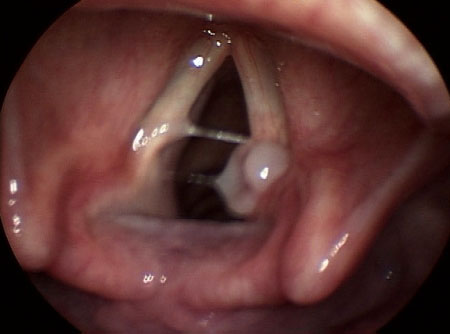 [Figure caption and citation for the preceding image starts]: 肉芽肿 2由 Wisconsin 大学医药和公共健康学院提供 [Citation ends].如果未消除基础病因,则肉芽肿的治疗后复发率较高。
[Figure caption and citation for the preceding image starts]: 肉芽肿 2由 Wisconsin 大学医药和公共健康学院提供 [Citation ends].如果未消除基础病因,则肉芽肿的治疗后复发率较高。
声带瘢痕的特征是声带上皮黏弹性丧失导致固有层浅层永久性的改变,是由长期发声创伤、喉显微外科手术或治疗头颈癌喉放射治疗所致。
复发性呼吸道乳头状瘤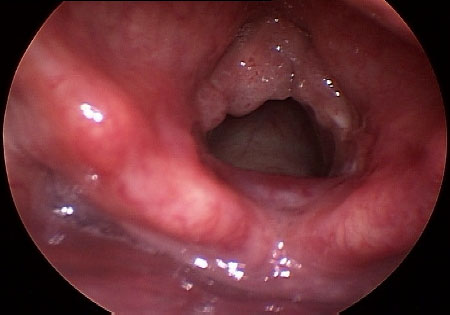 [Figure caption and citation for the preceding image starts]: 复发性呼吸道乳头状瘤由 Wisconsin 大学医药和公共健康学院提供 [Citation ends].
[Figure caption and citation for the preceding image starts]: 复发性呼吸道乳头状瘤由 Wisconsin 大学医药和公共健康学院提供 [Citation ends].
任克水肿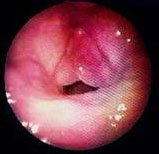 [Figure caption and citation for the preceding image starts]: 任克水肿由 Wisconsin 大学医药和公共健康学院提供 [Citation ends].
[Figure caption and citation for the preceding image starts]: 任克水肿由 Wisconsin 大学医药和公共健康学院提供 [Citation ends].
凝胶状物质堆积在声带固有层浅层,伴声带全长水肿(吸烟过量所致)。[7]Verdolini K, Rosen C, Branski R, eds. Classification manual for voice disorders: I. Mahwah, NJ: Lawrence Erlbaum Associates, Inc; 2005.暴露于环境污染物中、LPR 以及发声创伤是可能的作用因素。[7]Verdolini K, Rosen C, Branski R, eds. Classification manual for voice disorders: I. Mahwah, NJ: Lawrence Erlbaum Associates, Inc; 2005.
老年性声带萎缩
该术语描述可改变音质、音调和响度的年龄相关的生理学变化:组织萎缩、肌纤维质量减少、脂肪浸润增多、软骨骨化、关节炎以及呼吸支持减弱。[22]Pontes P, Brasolotto A, Behlau M. Glottic characteristics and voice complaint in the elderly. J Voice. 2005;19:84-94.http://www.ncbi.nlm.nih.gov/pubmed/15766853?tool=bestpractice.com
60 岁以上人群嘶哑的常见原因。[22]Pontes P, Brasolotto A, Behlau M. Glottic characteristics and voice complaint in the elderly. J Voice. 2005;19:84-94.http://www.ncbi.nlm.nih.gov/pubmed/15766853?tool=bestpractice.com
务必排除其他可能有早期累及且有类似嗓音特点的进行性神经系统疾病,例如帕金森病。
神经系统病因
继发于神经系统疾病的喉功能障碍可能首先表现为声音改变、吞咽障碍或呼吸困难,往往会被非专科医生漏诊。[23]Woodson G. Management of neurologic disorders of the larynx. Ann Otol Rhinol Laryngol. 2008;117:317-326.http://www.ncbi.nlm.nih.gov/pubmed/18564527?tool=bestpractice.com与发声和言语相关的任何神经解剖系统和通路(小脑、锥体外系、上位和下位运动神经元、神经肌肉接头、肌单位)受损都可导致嘶哑。[24]Mau T, Courey MS. Voice and speech abnormalities in systemic neurodegenerative disorders. In: Merati AL, Bielamowicz SA, eds. Textbook of laryngology. San Diego, CA: Plural Publishing; 2006.造成声音嘶哑的 4 个最常见神经系统病因是声带完全麻痹或不全麻痹、运动功能减退性构音障碍、特发性震颤以及痉挛性发音困难。
声带完全麻痹或不全麻痹
可能原因为完全没有活动能力(完全麻痹)或具有部分活动能力,表现为部分功能障碍(不全麻痹)。这些术语用于描述单侧或双侧杓状软骨复合体活动不能或活动减弱。
支配喉内肌的喉返神经或喉上神经的单侧或双侧的损伤或病变可导致声音嘶哑。
单侧声带麻痹最常见于特发性或继发于神经功能障碍。[25]Meyer T, Sulica L, Blitzer A. Vocal fold paralysis. In: Merati AL, Bielamowicz SA, eds. Textbook of laryngology. San Diego, CA: Plural Publishing; 2006: 217-235.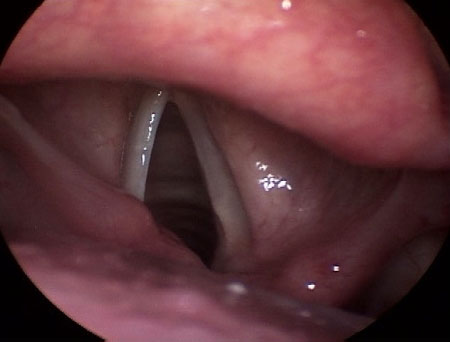 [Figure caption and citation for the preceding image starts]: 左侧声带麻痹由 Wisconsin 大学医药和公共健康学院提供 [Citation ends].其他病因包括手术创伤(甲状腺切除术、颈椎前路融合术、胸主动脉瘤修复、食管切除术、颅底手术)和中心静脉插管;脑、颅底、甲状腺、胸腺以及食管的恶性或良性肿瘤;咽旁隙肿瘤和迷走神经瘤;神经系统疾病(卒中、肌萎缩性侧索硬化、脊髓灰质炎后综合征、Charcot-Marie-Tooth 症、延髓性麻痹)。
[Figure caption and citation for the preceding image starts]: 左侧声带麻痹由 Wisconsin 大学医药和公共健康学院提供 [Citation ends].其他病因包括手术创伤(甲状腺切除术、颈椎前路融合术、胸主动脉瘤修复、食管切除术、颅底手术)和中心静脉插管;脑、颅底、甲状腺、胸腺以及食管的恶性或良性肿瘤;咽旁隙肿瘤和迷走神经瘤;神经系统疾病(卒中、肌萎缩性侧索硬化、脊髓灰质炎后综合征、Charcot-Marie-Tooth 症、延髓性麻痹)。
双侧声带麻痹的病因与单侧声带麻痹相似,但明显更为少见。常见病因包括甲状腺切除术、先天性疾病(Chiari 畸形)、脑干病变、长期插管、头颈放射性纤维化以及肉芽肿性疾病(肺结核、结节病、淀粉样变性)。[25]Meyer T, Sulica L, Blitzer A. Vocal fold paralysis. In: Merati AL, Bielamowicz SA, eds. Textbook of laryngology. San Diego, CA: Plural Publishing; 2006: 217-235.
运动功能减退性构音障碍
最常见的病因是帕金森病,是一种以基底神经节中多巴胺水平下降为特征的退行性运动障碍。声音和交流障碍的发生率较高,其中约 75% 至 90% 的患者会经历某种形式的言语困难,例如,音量过低、语言可懂度受影响以及言语单调。[26]Trail M, Fox C, Ramig LO, et al. Speech treatment for Parkinson's disease. NeuroRehabilitation. 2005;20:205-221.http://www.ncbi.nlm.nih.gov/pubmed/16340101?tool=bestpractice.com
特发性震颤
一种与年龄相关的运动障碍,其特征为运动时出现不自主震颤,在约 25% 至 30% 的病例中会对声音造成影响。[27]Sulica L, Louis E. Essential voice tremor. In: Merati AL, Bielamowicz SA, eds. Textbook of laryngology. San Diego, CA: Plural Publishing; 2006: 245-253.务必鉴别特发性震颤与帕金森病和痉挛性发音困难。
痉挛性发音困难
一种喉肌张力或运动障碍,是由于喉外展肌或喉内收肌痉挛导致声音嘶哑。[7]Verdolini K, Rosen C, Branski R, eds. Classification manual for voice disorders: I. Mahwah, NJ: Lawrence Erlbaum Associates, Inc; 2005.准确病因尚不明确,但肌肉痉挛可能继发于外伤。在开始使用肉毒素治疗痉挛性发音困难之前,必须先排除肌紧张性发音障碍。[28]Blumin JH, Berke GS. Spasmodic dsyphonia. In: Merati AL, Bielamowicz SA, eds. Textbook of laryngology. San Diego, CA: Plural Publishing; 2006.
声带恶性/恶性倾向病变
病因包括喉部恶性肿瘤,其中最常见的是声带癌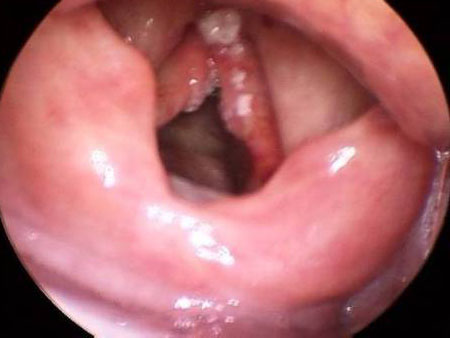 [Figure caption and citation for the preceding image starts]: 声带癌由 Wisconsin 大学医药和公共健康学院提供 [Citation ends].以及白斑这一具有恶性倾向的疾病。
[Figure caption and citation for the preceding image starts]: 声带癌由 Wisconsin 大学医药和公共健康学院提供 [Citation ends].以及白斑这一具有恶性倾向的疾病。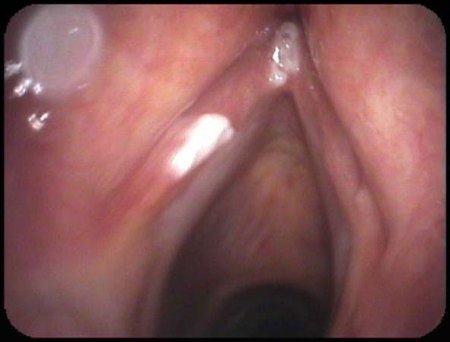 [Figure caption and citation for the preceding image starts]: 黏膜白斑病由 Wisconsin 大学医药和公共健康学院提供 [Citation ends].
[Figure caption and citation for the preceding image starts]: 黏膜白斑病由 Wisconsin 大学医药和公共健康学院提供 [Citation ends].
最常见的喉恶性肿瘤是鳞状细胞癌,其次为腺癌和淋巴瘤。[29]Hoffman HT, Karnell LH, Funk GF, et al. The National Cancer Data Base report on cancer of the head and neck. Arch Otolaryngol Head Neck Surg. 1998;124:951-962.http://archotol.ama-assn.org/cgi/content/full/124/9/951http://www.ncbi.nlm.nih.gov/pubmed/9738803?tool=bestpractice.com应鉴别肉芽肿与鳞状细胞癌。[30]Hoffman HT, Overholt E, Karnell M, et al. Vocal process granuloma. Head Neck 2001;23:1061-1074.http://www.ncbi.nlm.nih.gov/pubmed/11774392?tool=bestpractice.com发生喉恶性肿瘤的最重要危险因素是吸烟,而过量饮酒则会进一步加大这一风险。[8]Altman KW. Vocal fold masses. Otolaryngol Clin North Am. 2007;40:1091-1108.http://www.ncbi.nlm.nih.gov/pubmed/17765697?tool=bestpractice.com[31]Hunt JP, McWhorter AJ. Malignant neoplasms of the larynx. In: Merati AL, Bielamowicz SA, eds. Textbook of laryngology. San Diego, CA: Plural Publishing; 2006.其他危险因素包括人类乳头状瘤病毒(16 和 18 亚型)感染[32]Watts SL, Brewer EE, Fry TL. Human papillomavirus DNA types in squamous cell carcinomas of the head and neck. Oral Surg Oral Med Oral Pathol. 1991;71:701-707.http://www.ncbi.nlm.nih.gov/pubmed/1648190?tool=bestpractice.com以及 GORD。[33]Galli J, Cammarota G, Volante M, et al. Laryngeal carcinoma and laryngo-pharyngeal reflux disease. Acta Otorhinolaryngol Ital. 2006;26:260-263.http://www.ncbi.nlm.nih.gov/pubmed/17345929?tool=bestpractice.com[34]Vaezi MF, Qadeer MA, Lopez R, et al. Laryngeal cancer and gastroesophageal reflux disease: a case-control study. Am J Med. 2006;119:768-776.http://www.ncbi.nlm.nih.gov/pubmed/16945612?tool=bestpractice.com
白斑是继发于吸烟或过量饮酒的声带上皮癌前病变。[35]Isenberg JS, Crozier DL, Dailey SH. Institutional and comprehensive review of laryngeal leukoplakia. Ann Otol Rhinol Laryngol. 2008;117:74-79.http://www.ncbi.nlm.nih.gov/pubmed/18254375?tool=bestpractice.com既往头颈部放疗和 LPR 也可能与白斑发生有关。[31]Hunt JP, McWhorter AJ. Malignant neoplasms of the larynx. In: Merati AL, Bielamowicz SA, eds. Textbook of laryngology. San Diego, CA: Plural Publishing; 2006.[34]Vaezi MF, Qadeer MA, Lopez R, et al. Laryngeal cancer and gastroesophageal reflux disease: a case-control study. Am J Med. 2006;119:768-776.http://www.ncbi.nlm.nih.gov/pubmed/16945612?tool=bestpractice.com[36]Sinard RJ, Netterville JL, Ossoff RH. Squamous cell cancer of the larynx. In: Ossoff RH, Shapshay SM, Woodson G, et al, eds. The larynx. Philadelphia, PA: Lippincott Williams and Wilkins; 2003: 337.
 [Figure caption and citation for the preceding image starts]: Mirza 炎症树经许可转载自 Merati AL 和 Bielamowicz SA(编)。喉科学教材。加利福尼亚圣地亚哥:Plural Publishing 公司于 2006 年出版。保留所有权利。 [Citation ends].
[Figure caption and citation for the preceding image starts]: Mirza 炎症树经许可转载自 Merati AL 和 Bielamowicz SA(编)。喉科学教材。加利福尼亚圣地亚哥:Plural Publishing 公司于 2006 年出版。保留所有权利。 [Citation ends]. [Figure caption and citation for the preceding image starts]: 反流性喉炎由 Wisconsin 大学医药和公共健康学院提供 [Citation ends].
[Figure caption and citation for the preceding image starts]: 反流性喉炎由 Wisconsin 大学医药和公共健康学院提供 [Citation ends]. [Figure caption and citation for the preceding image starts]: 声带息肉由 Wisconsin 大学医药和公共健康学院提供 [Citation ends].纤维性肿块、肉芽肿和瘢痕
[Figure caption and citation for the preceding image starts]: 声带息肉由 Wisconsin 大学医药和公共健康学院提供 [Citation ends].纤维性肿块、肉芽肿和瘢痕 [Figure caption and citation for the preceding image starts]: 声带囊肿由 Wisconsin 大学医药和公共健康学院提供 [Citation ends].黏液潴留囊肿是由于黏液腺阻塞,表皮样囊肿则是由发声创伤或声带上皮残留在固有层中层引起。[7]
[Figure caption and citation for the preceding image starts]: 声带囊肿由 Wisconsin 大学医药和公共健康学院提供 [Citation ends].黏液潴留囊肿是由于黏液腺阻塞,表皮样囊肿则是由发声创伤或声带上皮残留在固有层中层引起。[7] [Figure caption and citation for the preceding image starts]: 肉芽肿 1由 Wisconsin 大学医药和公共健康学院提供 [Citation ends].
[Figure caption and citation for the preceding image starts]: 肉芽肿 1由 Wisconsin 大学医药和公共健康学院提供 [Citation ends]. [Figure caption and citation for the preceding image starts]: 肉芽肿 2由 Wisconsin 大学医药和公共健康学院提供 [Citation ends].如果未消除基础病因,则肉芽肿的治疗后复发率较高。
[Figure caption and citation for the preceding image starts]: 肉芽肿 2由 Wisconsin 大学医药和公共健康学院提供 [Citation ends].如果未消除基础病因,则肉芽肿的治疗后复发率较高。 [Figure caption and citation for the preceding image starts]: 复发性呼吸道乳头状瘤由 Wisconsin 大学医药和公共健康学院提供 [Citation ends].
[Figure caption and citation for the preceding image starts]: 复发性呼吸道乳头状瘤由 Wisconsin 大学医药和公共健康学院提供 [Citation ends]. [Figure caption and citation for the preceding image starts]: 任克水肿由 Wisconsin 大学医药和公共健康学院提供 [Citation ends].
[Figure caption and citation for the preceding image starts]: 任克水肿由 Wisconsin 大学医药和公共健康学院提供 [Citation ends]. [Figure caption and citation for the preceding image starts]: 左侧声带麻痹由 Wisconsin 大学医药和公共健康学院提供 [Citation ends].其他病因包括手术创伤(甲状腺切除术、颈椎前路融合术、胸主动脉瘤修复、食管切除术、颅底手术)和中心静脉插管;脑、颅底、甲状腺、胸腺以及食管的恶性或良性肿瘤;咽旁隙肿瘤和迷走神经瘤;神经系统疾病(卒中、肌萎缩性侧索硬化、脊髓灰质炎后综合征、Charcot-Marie-Tooth 症、延髓性麻痹)。
[Figure caption and citation for the preceding image starts]: 左侧声带麻痹由 Wisconsin 大学医药和公共健康学院提供 [Citation ends].其他病因包括手术创伤(甲状腺切除术、颈椎前路融合术、胸主动脉瘤修复、食管切除术、颅底手术)和中心静脉插管;脑、颅底、甲状腺、胸腺以及食管的恶性或良性肿瘤;咽旁隙肿瘤和迷走神经瘤;神经系统疾病(卒中、肌萎缩性侧索硬化、脊髓灰质炎后综合征、Charcot-Marie-Tooth 症、延髓性麻痹)。 [Figure caption and citation for the preceding image starts]: 声带癌由 Wisconsin 大学医药和公共健康学院提供 [Citation ends].以及白斑这一具有恶性倾向的疾病。
[Figure caption and citation for the preceding image starts]: 声带癌由 Wisconsin 大学医药和公共健康学院提供 [Citation ends].以及白斑这一具有恶性倾向的疾病。 [Figure caption and citation for the preceding image starts]: 黏膜白斑病由 Wisconsin 大学医药和公共健康学院提供 [Citation ends].
[Figure caption and citation for the preceding image starts]: 黏膜白斑病由 Wisconsin 大学医药和公共健康学院提供 [Citation ends].